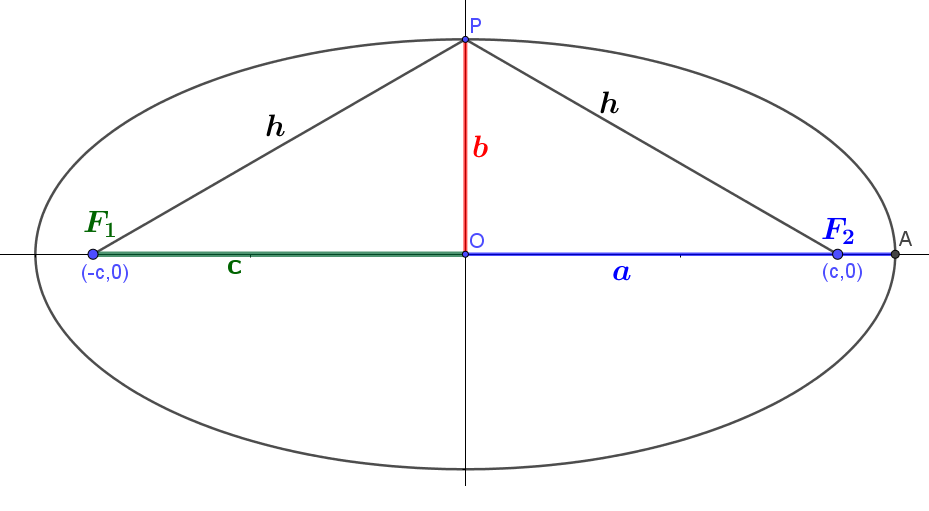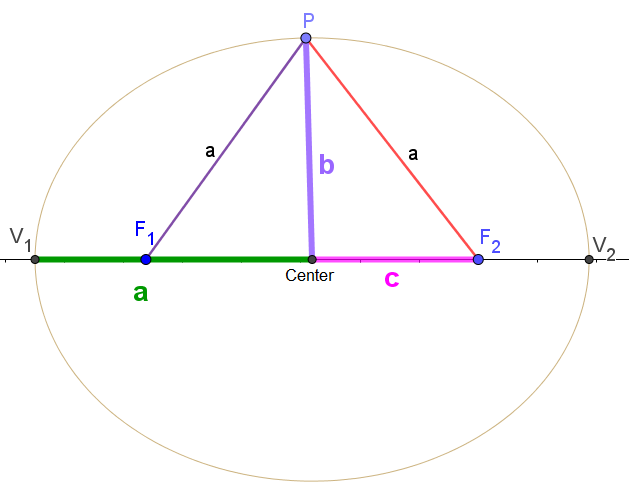Cartesian Derivation of the Ellipse
Definition 1: An ellipse is a closed curve about two focal points. At every point, $P$, on the curve, the sum of the distances to the two focal points is a constant equal to twice the distance from the ellipse center to the most distant point on the ellipse.

Lemma: Lemma 13.29.1. In an ellipse, the distance from the co-vertex, defined as the vertex at the ellipse end of a semi-minor axis, to a focal point has length a. This is the same length as the semi-major axis. In figure 1 it is labeled $h$ for hypotenuse.
Proof: Define $c$ as the distance from the elliptic center to focal point, $F_{1}$, and as the distance from elliptic center to $F_{2}$. Define $b$ as the semi-minor axis length and $a$ as the semi-major axis length. By Pythagoras, $h=\sqrt{b^{2}+c^{2}}$. By the definition of an ellipse, $h+h=2h=Konstant$. Now consider point $A$ located at the right vertex in figure 1. Point $A$ is also a point on the ellipse and its distance to the two focal points must be the same $Konstant$. So the distance $|A-F_{2}|=a-c$. The distance $|A-F_{1}|=a+c$. Therefore the combined distance from $A$ to the two focal points is $a-c+a+c=2a=Konstant$. Since $2h=Konstant$ and $2a=Konstant$, then $h=a$.

Theorem: The equation for an ellipse centered at the origin can be written as $$\frac{x^{2}}{a^{2}}+\frac{y^{2}}{b^{2}}=1,$$ where $a$ is the semi-major axis length and $b$ is the semi-minor axis length.
Proof: Using figure 1 and the definition of an ellipse, we can derive algebraically the standard elliptic equation. We begin with the definition, expressed as the sum of two distances and set them to the constant, $2a$. We let some point on the ellipse have coordinates $(x,y)$. Let the origin, $(0,0)$ be at the elliptic center. Then the $F_1$ coordinates are $(-c,0)$ and the $F_2$ coordinates are $(c,0)$. Therefore the distances from $F_1$ and $F_2$ to $(x,y)$ are $|F_1-(x,y)|=\sqrt{(-c-x)^2+(0-y)^2}$
and
$|F_2-(x,y)|=\sqrt{(c-x)^2+(0-y)^2}$
Then our definition:
$$\sqrt{(c+x)^{2}+y^{2}}+\sqrt{(c-x)^{2}+y^{2}}=2a \tag{1} \label{1}$$
Move the first term to the right hand side.
$$\sqrt{(c-x)^{2}+y^{2}}=2a-\sqrt{(c+x)^{2}+y^{2}} \tag{2} \label{2}$$
Square both sides.
$$(c-x)^{2}+y^{2}=\left(2a-\sqrt{(c+x)^{2}+y^{2}}\right)^{2}$$
Expand both sides.
$$c^{2}-2cx+x^{2}+y^{2}=4a^{2}+c^{2}+2cx+x^{2}+y^{2}-4a\sqrt{c^{2}+2cx+x^{2}+y^{2}}$$
Cancel terms.
$$-2cx=4a^{2}+2cx-4a\sqrt{c^{2}+2cx+x^{2}+y^{2}}$$
Move the $cx$ term to the right and the square term to the left.
$$4a\sqrt{c^{2}+2cx+x^{2}+y^{2}}=4a^{2}+2cx+2cx$$
Combine the $cx$ terms and then cancel out the factor $4$.
$$a\sqrt{c^{2}+2cx+x^{2}+y^{2}}=a^{2}+cx$$
Square both sides.
$$a^{2}\left(c^{2}+2cx+x^{2}+y^{2}\right)=\left(a^{2}+cx\right)^{2}$$
Expand both sides.
$$a^{2}c^{2}+2a^{2}cx+a^{2}x^{2}+a^{2}y^{2}=a^{4}+2a^{2}cx+c^{2}x^{2}$$
Cancel the $2a^{2}cx$ term from both sides.
$$a^{2}c^{2}+a^{2}x^{2}+a^{2}y^{2}=a^{4}+c^{2}x^{2}$$
Collect the $x$ and $y$ terms on the left and the constant terms on the right.
$$a^{2}x^{2}-c^{2}x^{2}+a^{2}y^{2}=a^{4}-a^{2}c^{2}$$
Factor both sides.
$$(a^{2}-c^{2})x^{2}+a^{2}y^{2}=(a^{2}-c^{2})a^{2}$$
From figure 1 replace $(a^{2}-c^{2})$ with $b^{2}$.
$$b^{2}x^{2}+a^{2}y^{2}=b^{2}a^{2}$$
Divide through by $b^{2}a^{2}$.
$$\frac{b^{2}x^{2}}{b^{2}a^{2}}+\frac{a^{2}y^{2}}{b^{2}a^{2}}=\frac{b^{2}a^{2}}{b^{2}a^{2}}$$
Cancel out terms and voilà.
$$\frac{x^{2}}{a^{2}}+\frac{y^{2}}{b^{2}}=1 \qquad \quad \square$$